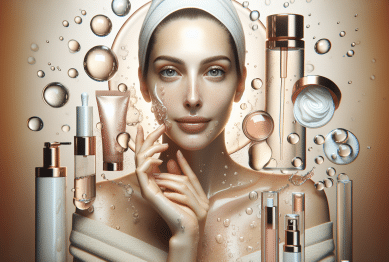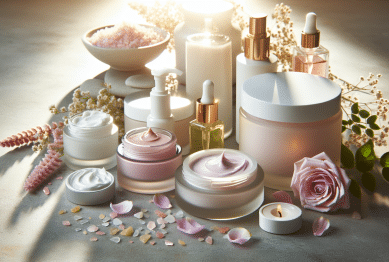Curious about the latest trend in skin wellness? Discover how microbiome skincare can help support glowing, resilient skin and why many are turning to balanced skin bacteria for a healthier look. Dive deep into this guide to learn how gentle routines can make a difference.
Understanding Your Skin’s Microbiome
The skin microbiome is a community of billions of bacteria, fungi, and viruses living on the skin. This ecosystem is essential for maintaining skin health and serves as a first line of defense against harmful pathogens. Researchers have discovered that a healthy balance within this layer can protect skin from dryness, irritation, and even premature aging. The trend of microbiome skincare focuses on nurturing these beneficial microbes instead of stripping them away, which could open doors to visible results in skin health. Supporting the microbiome is not just about new products—it’s about a new philosophy in skin wellness.
Moisturizers, cleansers, and even serums are now being developed with the skin microbiome in mind. Instead of over-cleansing or using harsh chemicals, people are looking into gentle formulations that respect and feed beneficial skin bacteria. This approach may help minimize flare-ups in sensitive skin and foster a balanced environment, which is important for anyone dealing with dry patches, redness, or sudden breakouts. With growing scientific interest in microbiota, microbiome skincare keeps gaining traction, and many are getting curious about how these novel routines can help their skin barrier stay strong.
Scientific research increasingly highlights connections between an imbalanced microbiome and skin concerns like eczema, acne, and rosacea. Even sun damage and environmental stress play a role in shifting this barrier’s harmony. By keeping the delicate ecosystem in mind when shopping for skincare or changing routines, individuals may experience long-term improvements. Industry experts suggest that supporting your microbiome can help the skin retain moisture more efficiently, leading to a healthier texture and appearance. The focus has truly moved from mere surface care to respecting this natural layer of defense.
Core Benefits of Microbiome-Focused Skincare
Fortifying the skin’s protective barrier is a primary benefit of microbiome skincare. When this layer thrives, it can block out environmental stressors and decrease sensitivity. Regular use of products designed to support skin flora often yields fewer outbreaks or inflammation. For many, this translates into visibly calmer, stronger skin, especially when integrating hydrating ingredients like squalane and ceramides along with prebiotics and probiotics. Such an approach provides comprehensive care that considers both the physical and microbial needs of the body’s largest organ.
Studies have suggested that nourishing the skin’s microbiome may significantly improve hydration, texture, and resilience to irritants. Unlike older routines that focused primarily on exfoliation or oil control, microbiome-supporting products work to restore balance. Skin exposed to a healthy mix of good bacteria can better retain moisture and withstand external disturbances. This often results in a supple, smoother complexion and improved tolerance to changing environmental conditions. Some evidence hints at less visible redness and irritation, making microbiome-based routines suitable for those with sensitive skin.
Freedom from harsh treatments is another hidden benefit. People often find that by shifting away from aggressive cleansers, overuse of acids, or excessive exfoliation, their skin is less prone to inflammation and dryness. This fosters a more adaptable, radiant appearance over time because the healthy bacteria are able to repair and protect skin on a microscopic level. Microbiome skincare is also considered more sustainable, as it avoids stripping the skin of necessary oils, focusing instead on nurturing and maintaining natural balance. This emerging approach blends tradition and innovation in skincare.
Microbiome Skincare Ingredients to Look For
Not all skincare products are created equal, especially when it comes to microbiome support. Look for formulations with prebiotics, probiotics, and postbiotics. Prebiotics are plant-based compounds that feed beneficial skin bacteria, such as inulin or oatmeal extract. Probiotics are live, friendly bacteria—most often found in fermented complex ingredients like lactobacillus ferment. Postbiotics are byproducts created by bacteria that can help soothe inflammation and reinforce natural defenses. The integration of these elements can nourish skin in a gentle yet effective manner.
In addition to specialized ingredients, microbiome-supportive products often contain soothing botanicals. Aloe, green tea, and calendula are popular choices due to their calming effects and antioxidant profiles. These elements not only prevent irritation but also help the microbiome fend off pollution and stress. Avoiding sulfates, parabens, and unnecessary fragrances is key, as harsh additives disrupt microbial balance. Those adopting a microbiome skincare routine often see the benefits when switching to thoughtfully formulated products that highlight these features.
Hydrating components, such as hyaluronic acid and glycerin, are also microbiome-friendly. They help retain moisture crucial for both skin and microbial health. Brands are now embracing the science by launching lines that clearly state microbiome support as a benefit, making it easier for consumers to make informed choices. Some serums and creams even include barrier-strengthening peptides which work in harmony with microbial functions. Over time, an ingredient-conscious routine enhances both comfort and visible skin wellness, offering a holistic experience rather than just temporary results.
Building a Microbiome-Friendly Routine
Transitioning to a microbiome-focused routine is about making gentle changes. Start with a mild, non-foaming cleanser that avoids stripping essential oils. Cleansing only when needed—often at night and after sweaty activities—reduces exposure to aggressive surfactants. Follow with hydrating toners or mists that do not disturb the skin’s pH balance. Adding a microbiome-focused serum can further fortify natural defenses, while lightweight moisturizers lock in hydration and provide nourishment for beneficial bacteria.
Sunscreen is a daily necessity for microbiome wellness. The right sunscreen protects not only from UV damage but also shields the delicate microbial community from environmental stressors. Choose mineral-based options or those that avoid alcohol and heavy fragrances to maintain this balance. Many experts recommend patch-testing new products, especially those claiming microbiome support, as everyone’s skin is unique. This careful approach helps identify any reactions and supports a smoother transition in your skincare journey.
One of the best approaches is to introduce new products one at a time. Monitoring how the skin responds makes it easier to pinpoint what works well and what causes irritation. Many individuals find it takes a few weeks to see noticeable differences—like less redness, fewer breakouts, or more supple skin. Remember, patience pays off. Sticking to a simple, microbiome-centered routine may yield long-term resilience and a naturally radiant glow that harsh regimens cannot provide. Consistency matters more than perfection.
Addressing Common Concerns and Misconceptions
Some may wonder whether microbiome skincare is just another trend. However, scientific backing has solidified its place in wellness-driven routines. Many initial doubts relate to the idea of putting bacteria on skin. It may sound counterintuitive, but modern research shows that good bacteria support the body’s natural defenses and can even outcompete problematic microbes. Purity is not always healthiest; a certain level of diversity actually helps protect and rejuvenate the skin, especially for those with sensitive or reactive complexions.
Another concern is the effectiveness of over-the-counter microbiome skincare. While not all probiotic or prebiotic products are the same, some offer real benefits when combined with an overall gentle routine. Labels can be confusing, so learning about key ingredients and reading scientific reviews can help. For persistent skin issues, consulting a dermatologist is wise. They may recommend specific microbiome-supportive products, but the main idea is to avoid over-cleansing or targeting bacteria harshly, as this can lead to imbalances.
There is no need for perfection. While a balanced microbiome matters, occasional disruptions—like stress, diet changes, or new environments—are natural. The body, including the skin, is remarkably adaptable. Focusing on gentle, regular care and supporting the microbiome often proves more effective than forcing harsh treatments. With time, as more learn about microbiome skincare, outdated myths are being replaced with facts and realistic routines—making healthy skin achievable for many, not just a select few.
Your Lifestyle and Its Impact on Skin Wellness
Everyday choices influence skin wellness beyond the products used. Diet, sleep, stress, and air quality all relate closely to the microbiome. Research points to fiber-rich foods and hydrated lifestyles as supporting gut and skin health together. Consuming prebiotic foods like bananas, oats, and asparagus, for example, may offer indirect benefits for the microbiome by nourishing good bacteria throughout the body. A holistic view matters—skincare is just one part of the puzzle.
Sleep and stress management are critical. Lack of sleep increases inflammation markers, which can throw the skin and its microbiome out of balance. Simple mindfulness practices, regular exercise, and fun activities reduce stress, making it easier for the body to heal and reset. Cleaner indoor air (such as using air purifiers) may also help by lowering the load of irritants that can disrupt both the skin barrier and its microbial layer. Wellness routines that nurture the whole person reflect positively on skin appearance over time.
Hydration is equally significant. Both systemic and topical hydration supports a healthy microbiome. Drinking water, eating hydrating foods, and applying water-binding moisturizers unite internal and external self-care. Many find that prioritizing wellness and mindful habits reduces flare-ups and makes any skincare routine—especially microbiome-focused ones—more effective. Over time, a synergy develops, helping the skin glow from the inside out. Your daily lifestyle offers the foundation for everything else.
References
1. National Institutes of Health. (n.d.). Skin Microbiome. Retrieved from https://www.nih.gov/news-events/nih-research-matters/skin-microbiome
2. American Academy of Dermatology Association. (n.d.). How to Maintain a Healthy Skin Microbiome. Retrieved from https://www.aad.org/public/everyday-care/skin-care-basics/care/skin-microbiome
3. Harvard Health Publishing. (n.d.). Do ‘probiotic’ skin-care products really work? Retrieved from https://www.health.harvard.edu/blog/do-probiotic-skin-care-products-really-work-2020040219410
4. Mayo Clinic. (n.d.). Skin Care: 5 Tips for Healthy Skin. Retrieved from https://www.mayoclinic.org/healthy-lifestyle/adult-health/in-depth/skin-care/art-20048237
5. Journal of Dermatological Science. (n.d.). The Role of Microbiome in Skin Health. Retrieved from https://www.jdsjournal.com/article/S0923-1811(21)00126-4/fulltext
6. The British Association of Dermatologists. (n.d.). Prebiotics, Probiotics and the Skin. Retrieved from https://www.bad.org.uk/patient-sets/prebiotics-probiotics-and-the-skin/









